
Rode Wireless Micro: one-minute review
Rode’s Wireless Micro is its smallest-ever wireless mic system, designed squarely for smartphone content creators, especially vloggers. It’s the audio giant’s simplest wireless mic yet: you can be up and running within seconds and recording smartphone-beating audio quality, all the while being cable-free and discreet.
It’s a complete kit that includes two mics (also called transmitters) with magnetic attachments, plus one receiver, all of which are stored in a charging case – these components are available in black or white finishes. Additionally, you get two windshields plus a charging cable, though neither of those fit in the case.
Collectively, the mics, receiver and charging case are a featherweight 3.6oz / 102g, with each mic weighing just 0.42oz / 12g and measuring 40 x 20 x 17mm. It’s a properly tiny kit, and even though the mic units are physically larger than the rival DJI Mic Mini‘s, the whole kit is much smaller, and purpose-built for smartphones.
If you’re looking for a compact, dedicated wireless mic that’ll deliver excellent audio for your smartphone vlogs, the Rode Wireless Micro is hard to beat.
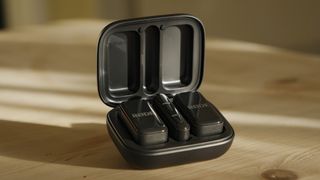
Rode Wireless Micro: price and release date
- $149 / £134 / AU$259 for the compete kit with 2x mics, receiver and charging case
- Receiver available in USB-C and Lightning versions
- Available now, in black or white finishes
The Rode Wireless Micro’s list price is $149 / £134 / AU$259, and for that you get a compact charging case with two transmitters (mics, with magnetic attachments), plus one receiver, all in black or white. Also in the box are two wind shields and the necessary charging cable. You’ll need to select which version of the receiver you need, USB-C or Lightning, because the connector is built-in.
Unlike the rival DJI Mic Mini, the components are not available separately, and I think Rode is missing a trick here, because not every user needs two mics. However, probably nine out of 10 users will want the complete kit, and for those the Rode Wireless Micro is excellent value.
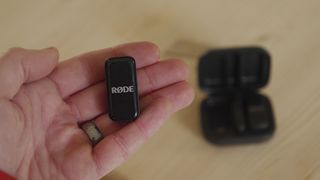
Rode Wireless Micro: specs
| Dimensions | Transmitter: 40 x 27 x 17mm (L x W x H) Receiver: 44 x 24 x 9mm (L x W x H) |
| Weight | 12g (transmitter, without magnet), 102g for the whole kit |
| Transmission range | Over 100m |
| Connectivity | Receiver: USB-C or Lightning |
| Battery | 7 hours, plus two additional charges from the case |
| Audio | 24-bit |
| Noise cancelling | No |
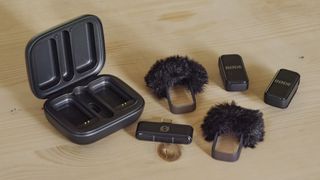
Rode Wireless Micro: Design
- The whole kit weighs just 102g and fits in a tiny charging case
- Components are available in black or white finishes
- Receiver has a USB-C or Lightning adapter built in
Rode has designed the Wireless Micro to be the most straightforward user experience possible for smartphone content creators, and it’s done an excellent job of it – you couldn’t hope for an easier-to-use and more reliable wireless mic.
The mics and receiver are automatically paired by virtue of living in the same charging hub. You simply plug the receiver into your phone and then follow the message that flashes up on your phone’s screen.
If you have Rode’s free app installed (available for iOS and Android) you’ll be taken to the app, where you can pair the mics and receiver, and choose to how route the receiver input: split for left and right channels, or merge audio into one channel. You can also update the mic’s firmware through the app and check sound levels.
For me, using a Google Pixel 6, I needed to select the wired mic option in my phone’s video menu in the camera app (it otherwise automatically selects the phone’s built-in mic). But once those options are all sorted, setup is complete and away you go.
You can be up and running in seconds after plugging the receiver into your smartphone’s charging port, and armed with a wireless mic system that takes care of all the audio levels for you – Rode says its Intelligent GainAssist technology gets “perfect audio every time”.
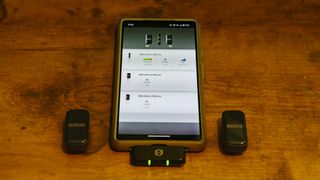
The mics can clip onto clothing, or attach magnetically with a strong hold through thin clothing, and they’re available in black or white, so you can choose the finish that’s likely to blend in with your clothing better.
The connection type is built in to the receiver, so you need to select the USB-C or Lightning version at the time or purchase, and there’s full compatibility with both Android and iPhone models. The DJI Mic Mini, on the other hand, has a slot to fix the USB-C or Lightning connector into place, so you only need one receiver even if you use both connection types (though the Lightning adapter is a separate purchase).
The DJI Mic Mini also features Bluetooth connectivity, and you can therefore bypass the receiver altogether for 16-bit audio (although a receiver provides a stabler connection and, in the Mic Mini’s case, 24-bit audio), whereas the Wireless Micro relies on its receiver.
Wind shields are built into the mics as part of Rode’s patent-pending acoustic chamber design, plus there are additional furry windshields in the box that clip around the receiver for clearer outdoor recording on breezy days, although these additional windshields won’t fit into the charging case.

Rode Wireless Micro: Performance
- Transmission range is over 100m
- 7 hours operating time, charging case can provide another two charges
- No noise reduction, but Intelligent Gain Assist gets you clear vocals
My experience with the Rode Wireless Micro has been as headache-free as I could hope for. Once I had the Rode app installed (though you don’t have to use the app to use the mic), I was up and running and capturing high-quality 24-bit audio with my Google Pixel 6 phone in a matter of seconds.
Rode says the Wireless Micro’s transmission range is over 100m, which is harder than you might think to fully test in the real world; how often – and indeed, why – would you need to record audio onto a phone camera from over 100m away?
The upshot is that for vlogging, the Wireless Micro provides a stable and reliable connection, with an operating time for each mic being around seven hours.
That operating time can be extended through the charging case, which features a 490mAh battery and can charge a transmitter an additional two times, effectively delivering an overall operating time of 21 hours. In short, with a charged case you’ll have enough juice for a weekend of vlogging.
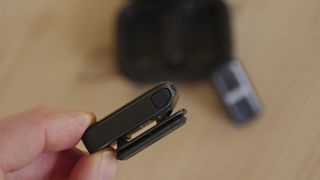
If you want to know a few of the technicals, the Wireless Micro features 24-bit audio, a 20Hz to 20kHz frequency range, a maximum 135db SPL, a 73db signal-to-noise ratio and an A-Weighted equivalent noise of 21dBA. For reference, those specs are roughly similar to those of the Rode Wireless ME, a pricier wireless mic that also works with cameras.
Rode’s ‘Intelligent GainAssist’ tech automatically controls audio levels for well-balanced sound, enhancing vocals, and freeing you to focus on creating. You miss out on noise reduction, but unless you’re in particularly loud environments it’s not a problem – I’ve been able to get clear recordings of my voice in a noisy soccer stadium, even if the animated crowd added to the video’s feel.
I’ve recorded vlogs in a range of scenarios; indoors, outdoors, and in noisy environments, and I’ve been very happy with how crisp my voice sounds. Put simply, if you want better audio without the fuss, this Rode mic is sure to delight.
Should I buy the Rode Wireless Micro?
Buy it if…
Don’t buy it if…
Rode Wireless Micro: also consider
| Header Cell – Column 0 | Rode Wireless Micro | DJI Mic Mini | DJI Mic 2 |
|---|---|---|---|
| Dimension | Transmitter: 40 x 27 x 17mm (L x W x H)Receiver: 44 x 24 x 9mm (L x W x H) | Transmitter: 26.6 x 26.1 x 16mm (L x W x H)Receiver: 46.5 x 29.6 x 19.3mm (L x W x H) | Transmitter: 46.1 x 31 x 21.8mm (L x W x H)Receiver: 54.2 x 28.4 x 22.5mm (L x W x H) |
| Weight | 12g (transmitter, without magnet), 102g for the whole kit | 10g (transmitter, without magnet) | 28g (transmitter, without magnet) |
| Transmission range | 100m | 400m | 250m |
| Connectivity | Receiver: USB-C or Lightning | Receiver: USB-C or Lightning, 3.5mm jack | Receiver: USB-C, 3.5mm jack |
| Battery | 7 hours (plus two additional charges from the fully charged case for a total of 21 hours) | 11.5 hours (transmitter), 10.5 hours (receiver), up to 48 hours with fully charged case | 6 hours (plus two additional charges from the fully charged case for a total of 18 hours) |
| Audio | 24-bit | 24-bit (drops to 16-bit via Bluetooth) | 32-bit float, 24-bit |
| Noise cancelling | No | Two-level, auto | AI |
| Bluetooth | No | Yes | Yes |

How I tested the Rode Wireless Micro
- Used regularly for over a month in quiet and noisy environments
- Tested alongside the rival DJI Mic Mini
- Paired primarily with a Google Pixel 6
There aren’t a lot of ways in which you can test the Rode Wireless Micro: it handles audio levels, clipping and vocal enhancement automatically, and that’s it appeal for most users. The mics and transmitter are auto-synced through the charging case, you plug the receiver into your phone, and away you go.
I did however make sure to test the audio quality of the Wireless Micro in mixed environments – the quiet indoors, the still outdoors, in wind, and in noisy environments. I was also reviewing the DJI Mic Mini at the same time, and so was able to run comparison tests to see which came out on top.
Almost all tests were done by pairing the Wireless Micro to my Google Pixel 6.
